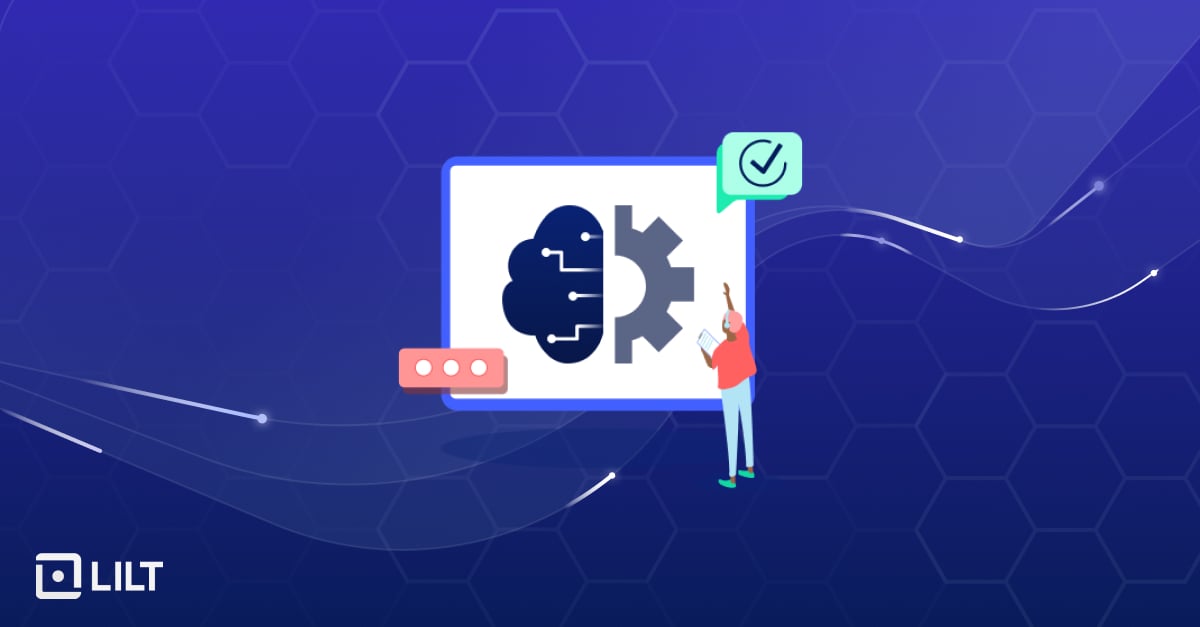What is your AI Translation Strategy? How to Operationalize New Language Technology

We recently hosted AI Day (webinar recording available here), where localization and research leaders from Lilt came together to help listeners build a foundation for an AI strategy to incorporate into enterprise translation. Featuring 3 keynote sessions, this webinar aimed to bridge the gap between cutting-edge AI technology, experienced research leaders, and customers who have AI translation needs.
With so many world languages, many of which are profoundly complex, generating perfect translations that fit the context of the original language can be challenging. As seen throughout our AI day, blended workforces that include both experienced linguists and well-trained AI systems are where localization is heading.
In this blog post, we'll discuss what AI translation is, how to choose the right AI translation strategy, and best practices for implementation. Read on to gain a better understanding of how to operationalize new language technology and create a successful AI translation strategy for your business.
Introduction
AI translation technology has grown exponentially over the past few years and provides more accurate translations faster than ever before. This technology gives enterprises the opportunity to reach and connect with customers across different languages and cultures, while also streamlining internal processes. Benefits of AI-driven translation include less time spent on manual tasks, better customer experiences, and consistent messaging across multiple channels.
Choosing an AI translation strategy requires careful consideration in order for organizations to get the most out of their technology investments. By evaluating their needs and researching available options carefully, organizations can ensure that they select the best fit for their unique situation.
Choose the Right AI Translation Strategy
To determine your AI strategy for translation, you must first determine the needs of your organization. Some important aspects to consider are cost, accuracy, scalability, volume, and speed. Here are some questions to take into consideration:
1. What is your budget?
2. How accurate do you need translations to be?
3. How do you plan to scale, and what volume of copy will you need to translate?
4. In how many languages?
5. How quickly will this all be taking place?
Once you have reviewed and determined your answers to these questions, you can select the approach that best suits your unique needs.
![]() Pro tip: You will also want to reduce as many manual steps and processes as possible. Investing in a Connector-first approach will serve you as your AI strategy for localization scales.
Pro tip: You will also want to reduce as many manual steps and processes as possible. Investing in a Connector-first approach will serve you as your AI strategy for localization scales.
How to Choose the Your AI Translation Solution and Technology
Once you’ve built the framework for your AI strategy, you’ll also need to decide which type of AI translation technology best fits your needs. Generally speaking, there are two main types to consider: rule-based systems and deep learning algorithms.
Rule-based systems use rules and dictionaries to translate, while deep learning algorithms use neural networks and statistical techniques to create more natural translations. Organizations should assess what kind of accuracy is needed in order to choose between these two options.
In addition, organizations must evaluate potential vendors before making a decision on an AI translation strategy. They should look at factors such as cost, quality assurance protocols, customer support services, scalability and security features offered by each vendor. It is important that organizations find a vendor that provides reliable service and can easily adjust to changing demands in order to get the most value out of their investment.
You will want to also consider consistency in training data. To get the most out of your AI, you will need to train it, with some limitations and specificity. The more you feed the AI, the more it learns, and you will want to make sure that it is learning correct approaches as opposed to mistakes.
Lastly, it’s important to compare the effectiveness of in-context learning between various systems. These are models that can take information about the context in which it's being used and specialize its responses to that environment—holding a clear advantage over prior systems when building an AI Strategy for localization that lives up to existing demand.
One such technology is Lilt’s proprietary in-context learning systems. Run by Lilt large language models, our Contextual AI Engine is instantly retraining, learning from linguist feedback in real-time. Trained on 5x more data than the models they are replacing, Lilt’s LLMs are built on transformer architecture to deliver translation with higher accuracy, ultimately driving improved translation quality and increased translation velocity. The instant retraining of the models further enables higher accuracy, greater consistency, and closer alignment to each customer’s specific brand voice. And while other companies like OpenAI cost millions (if not billions) to train their models, Lilt does this at a fraction of the price.

Best Practices to Implement
When approaching an AI localization strategy, it’s important to start testing and training the engine early on. To get started, assess projects that can use an AI strategy for translation quickly. You’ll also need to place initial limitations so that you can have the most precise contextual training process possible.
To train and utilize your AI translation solution, it’s important to build the right team to execute your strategy. This team will need to include individuals and stakeholders who can implement the AI tool early in the globalization or content development process.
When negotiating with possible vendors and solutions, be sure to ask about any discounts or special pricing options that may be available. You should also ask about any guarantees the vendor offers regarding the quality of its translations. By carefully considering all of these factors and negotiating with the vendor, you can choose an AI translation vendor that meets your needs and helps you achieve your business goals.
Lastly, continue to iterate and feed the AI engine. As with most learned skills, practice will be the best way to improve the AI system’s responses, ultimately training it to a place of near perfection, or at the very least, fewer edits for your skilled linguists.
Stay Ahead of the Curve with the Right Solution
Enterprises can stay ahead of the curve with the right AI strategy for localization. Advancements in AI can help brands stay resourceful and scale to meet the global market’s demands. And with so many different AI solutions on the market, it can be difficult to select the right solution that will not only guarantee efficient use of AI, but will also scale with your global growth.
The good news? Lilt is the leading AI solution for enterprise translation. Whether you’re just starting to embark on your AI journey or looking for opportunities to scale, Lilt’s AI solution and technology is built to make it as seamless as possible. Tune into our next AI blog to further understand how Lilt’s latest model can elevate your AI strategy for translation far above the curve.
Talk with one of our experts to learn more about Lilt’s pricing and start enhancing your localization strategy today.


.png)